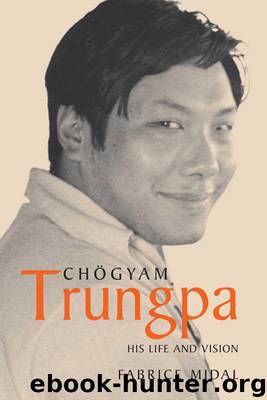Chogyam Trungpa by Midal Fabrice

Author:Midal, Fabrice [Midal, Fabrice]
Language: eng
Format: azw3, epub
Publisher: Shambhala Publications
Published: 2010-10-05T03:00:00+00:00
With his new girlfriend—
Like a general inspecting the troops.15
Encounters with Allen Ginsberg
In 1970, while Chögyam Trungpa, Diana Mukpo, and Kunga, one of his students, were getting into a taxi, a man came up to them and said, “My father is ill—may I take your cab?” Kunga recognized the man as Allen Ginsberg, the famous Beat poet and emblem of American counterculture. He introduced him to Chögyam Trungpa.
In fact, Allen Ginsberg had already met Chögyam Trungpa in India, while the latter was at the Young Lamas School, but neither of them remembered that encounter. It was only after Chögyam Trungpa’s death that Allen Ginsberg found a photo of himself with a young monk who had shown him the region around the school, and realized that the monk was none other than Chögyam Trungpa.
In any case, after this second meeting in New York, a sincere friendship began between the two. While Chögyam Trungpa introduced Allen Ginsberg to the Buddhist discipline of meditation, Ginsberg introduced him to the poetry of the Beat Generation, such as Jack Kerouac’s Mexico City Blues. He also explained the very idea behind modern poetry since Rimbaud and Apollinaire: poets had adopted a very free attitude toward language, as in the famous line of William Carlos Williams: “No ideas but in things,”16 which is an invitation to pay attention above all to the words themselves. From this viewpoint, Ginsberg criticized certain turns of phrase in Chögyam Trungpa’s poetry, such as the use of conventional metaphors like “galloping on a white horse.” He explained that without concrete reality, it was merely an image. Symbolism should be more lively and anchored in an experience of the power of words themselves. Rinpoche started to introduce these more contemporary ideas into his poetry and to pay more attention to the poetic dimension itself. This change is particularly striking between Mudra, published in 1972, and the collection First Thought Best Thought, which appeared eleven years later.
Here is an excerpt from a poem written in 1959:
The yogin who lives only in the hour
Download
This site does not store any files on its server. We only index and link to content provided by other sites. Please contact the content providers to delete copyright contents if any and email us, we'll remove relevant links or contents immediately.
The Way of Zen by Alan W. Watts(6505)
Ego Is the Enemy by Ryan Holiday(5294)
The Art of Happiness by The Dalai Lama(4063)
The Book of Joy by Dalai Lama(3899)
Why Buddhism is True by Robert Wright(3403)
Spark Joy by Marie Kondo(3249)
Shift into Freedom by Loch Kelly(3134)
Happiness by Matthieu Ricard(2989)
A Monk's Guide to a Clean House and Mind by Shoukei Matsumoto(2866)
The Lost Art of Good Conversation by Sakyong Mipham(2576)
The Meaning of the Library by unknow(2505)
The Unfettered Mind: Writings from a Zen Master to a Master Swordsman by Takuan Soho(2249)
The Third Eye by T. Lobsang Rampa(2225)
Anthology by T J(2159)
Red Shambhala by Andrei Znamenski(2148)
The Diamond Cutter by Geshe Michael Roach(2018)
Thoughts Without A Thinker: Psychotherapy from a Buddhist Perspective by Epstein Mark(1961)
Twilight of Idols and Anti-Christ by Friedrich Nietzsche(1848)
Advice Not Given by Mark Epstein(1839)
